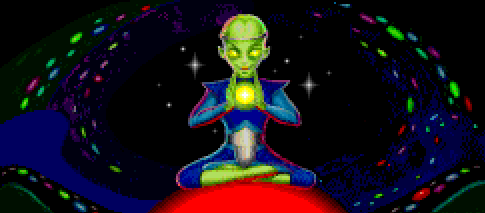
Paul Reiche III and Fred Ford, 1992
Star Control II is my favorite video
game.
This would probably be a more impressive statement if I had played more
than a handful of video games in the past twenty years.
Let’s see, there was
Civilization IV…
Europa Universalis II…
Alpha Centauri… and a bunch of casual
things I found on the web.
It’s better than Peggle is I guess what I am saying.
So let me rephrase.
Star Control II is one of my favorite
pieces of entertainment in any medium.
Once I even went so far as to say that I would give it the same perfect
score that I gave Watchmen.
(Before I go on, I should specify that I had her play the DOS version
that I played back in the ’90s, not the freeware version known as
The Ur-Quan Masters.
I have just enough OCD that The Ur-Quan Masters
drives me up the wall.
The navigation window fades between zoom levels instead of
cutting!
There’s an intrusive moving arrow in the dialogue
sequences!
The font tracking is wrong!
There’s an ellipsis where there’s not supposed to
be!
Nnnnnngaaaa!!!!
At least there’s an option to turn off the horrible voice tracks
that were added for the 3DO version back in 1994.
I would say that the voice acting is terrible, and it’s not
great, but that isn’t even the
problem—Star Control II
shouldn’t have voice acting at all!
The character of each alien’s communication style was intended to
be conveyed via music and typeface—the voices totally
undermine that.
Even putting that aside—some things are effective when
read, some are effective when spoken, and surprisingly few are
effective both ways.
So, how did it hold up?
Not perfectly, but pretty darn well.
The game begins with a short slideshow laying out the premise: in
the first half of the 22nd century, Earth and its allies were fighting
a losing war against the Ur-Quan Hierarchy, a group of aliens bent on
enslaving all free sentients.
A group of colonists was secretly sent to a nearby star system, where
you were born and grew up.
Now you have a powerful starship and have set off on your first voyage
to Earth, to see how your ancestral homeworld is faring in the war
and whether you can turn the tide.
Star Control II is very open-ended. You are plunked down in a sector of the galaxy containing over 500 stars and over 3800 worlds, and you can go to any of them your fuel tanks allow. At any given time you’ll have a few leads that give you some sense of where you might want to go, but initially your main goal is to gather minerals to improve the capabilities of your ship. And this is just a matter of exploration. You fly from star to star and planet to planet, scanning each one in turn until you find one worth landing on. This type of exploring was one of my favorite things about the game my first time through. It was also one of my favorite things about the game that established this genre, Starflight by Binary Systems. Starflight came out in the summer of 1986, and I spent many late nights that year in my father’s little home office, where the computer was. In Starflight, your scanners told you what kinds of minerals a planet had and how abundant they were, but not where they were; to get them, first you had to land, like so: Once you had landed, you moved your rover one square at a time, looking for the icon that indicated minerals. You then rolled up next to the minerals, went through a little menu to scan them, and then scrolled down to the command to pick them up. It was laborious—and yet it was also compelling. Sitting in that downstairs office at 2:30 a.m. while everyone else was upstairs sleeping, the sound of the sprinklers outside drowned out by the the grinding of the rover’s engines, I really felt as though I were rolling across the lonely, barren wastes of an alien planet. Star Control II mineral collection is more arcade-like. The map of each planet is much, much smaller, and you pick up minerals just by rolling over them, the way Pac-Man eats dots. There are no ghosts to chase you, but on some planets there are various sorts of alien beasties that you can tranquilize and put into stasis aboard your ship, if they don’t kill you first. You also have earthquakes, hotspots, and lightning strikes to dodge. Once you get far enough along in the game, you can buy tech that will protect your lander from these hazards, allowing you to visit planets that would have been too dangerous at the beginning. It definitely makes for livelier gameplay than the Starflight approach, and while it doesn’t evoke the same sense of traversing continents like the explorers of old, there was still something kind of awesome (in the pre-’80s sense) about hovering above each new planet, watching it rotate, listening to the music that played while you were in orbit. This time around I have to admit that I found myself reflecting from time to time about just how easy we all were to amuse back in the day. To think of the hours I spent on Tron Deadly Discs and the like… how many times can you de-rez a bunch of identical blue guys before it gets old? Similarly, how did it not get old to fly to hundreds of different planets and moons and see the same couple of dozen types appear in the window, the same blobs of minerals on the scanner? I would have guessed that this kind of repetitive busywork wouldn’t fly these days—but it turned out that scouting out planets and scooping up twenty units of astatine and shooting giant purple worms were just as absorbing to Zoe in 2013 as they were to me in 1992.
But there’s way more to Star
Control II than fetching rocks.
The sector of the galaxy in which the game takes place is inhabited by
something on the order of thirty spacefaring species, and your
interactions with them make up the heart of the game.
Some of these interactions involve combat; the original
Star Control was really just an update of
Spacewar, and while as far as I know I was the only one
in my dorm who played through the full Star
Control II adventure,
And the main reason I have loved Star
Control II so much is that these aliens make up a
wonderful, diverse, and sharply written cast of characters, rendered
in gorgeous pixel art.
The intimidating aliens are impressively intimidating.
The enigmatic aliens are compellingly enigmatic.
The funny aliens are hilarious—and each group of aliens
is hilarious in a very different way!
I do have some criticisms, but before I get to them, I should
emphasize that I still think the writing is extremely
strong—and that’s not just nostalgia talking,
because this was brand new to Zoe and she loved the dialogue and the
characterization as well.
Buuut… I do have to concede that this time around some of the
humor struck me as pretty puerile.
This is especially true where the player’s own dialogue options
are concerned.
You generally have a menu consisting of one or two bland statements or
questions (e.g., “We come in peace”, “What can you
tell us about your species?”), a death threat, and an insult that
wouldn’t be out of place on Beavis and
Butt-head.
Now, this in and of itself might not be particularly irksome.
(Incidentally, this is a big part of what my IF piece
Endless, Nameless
is about.
My feeling on the matter is that since players can never
really play themselves—in
Star Control II, the player character is
from the planet Unzervalt, and no actual player is from
Unzervalt—to
I want to conclude by saying a bit about the game’s design. Again, for the most part I thought it was very strong. In particular, I was impressed by the way that at any given point you could go anywhere, but there were pretty much always only a handful of places you wanted to go—not one, because that would make the game feel as though it were on rails, but not a million, because that would be overwhelming. (And not zero, because then you’d have no reason not to quit.) I do have a couple of criticisms, though. One is that as wonderful as the aliens were, they were also in some respects just a big group of lock-and-key puzzles: each group has something you want (even if you don’t yet know what it is), and you figure out what you have to give them or do for them to get them to give up their prize. Once they have, their role in the game is generally done. This can be a problem when you (a) have finished your productive interactions with a group of aliens, (b) are in their space, and (c) are slower than they are. You will be stuck having encounter after encounter that amounts to the two of you saying hello and goodbye. I know disk space was still at a premium back in 1992, but these days I might be tempted to load up each alien species with a huge selection of things to say (and Reiche and Ford actually did do this with at least one of them, to great effect). I guess the problem with that idea is that a lot of players don’t feel as though they’re done until they’ve seen everything the game has to offer, so they might sit there having a hundred encounters in a row with the same species just to exhaust the conversational options. And then be back in the same boat as before.
My second criticism of the game’s design has to do with
interactivity—specifically, the player’s freedom to
shape the story.
For the most part, Star Control II is
excellent on this score.
A lot of games—for one,
Star
Control 3 !—assume
that you will accomplish tasks in a certain order, and if you happen to
deviate from that, things go haywire—you find yourself
with conversational options referring to information you haven’t
actually heard yet, for instance.
That doesn’t happen in this game, which is really kind of
impressive for a game this large and open-ended.
What can happen, though, is that you miss pieces of information and
don’t realize it.
Graham Nelson famously described adventure games as “a crossword at war with a narrative”, and there is indeed a fundamental tension at the heart of the form. As a game designer, you want to hide the good stuff from players—it’s the prospect of that reward that motivates players to undertake the challenges you’ve set before them. But as an author, you want to make sure players don’t miss any of the good stuff, because if they do, they’ll have a lower opinion of your game! You’re sort of in an arms race against yourself. You might arrange things so that players can’t make it to the end unless they’ve seen all the good stuff… but then it’s tempting to put in Easter eggs, to give an extra reward to players who are clever enough to try unusual things. But then you still don’t want anyone to miss how clever you’ve been, so you add a “Have You Tried…?” section at the end to point out all your Easter eggs and make sure no one underrates your game. Now, apparently giving players the freedom to miss hearing the villains’ motivation didn’t hurt the reception of Star Control II any, for it is pretty much universally beloved, and rightly so. But as a general rule, the old-school “suboptimal play gets you gruesomely killed” beats the newer-school “suboptimal play gets you a less satisfying story and you might not even realize it” all hollow. And that just about wraps it up for this article, so I guess it’s time to say goodbye. Hello!! I am only joke. It is funny enough. Do not forget to *enjoy the sauce* !!!
|
|||||||||||||||||||||
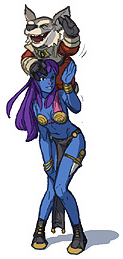 But that was quite some time ago—long enough ago that
Skype screen sharing hadn’t been invented yet.
Now it has, so recently I watched, listened, and kibitzed as my
pal Zoe the Squirrel played
But that was quite some time ago—long enough ago that
Skype screen sharing hadn’t been invented yet.
Now it has, so recently I watched, listened, and kibitzed as my
pal Zoe the Squirrel played 
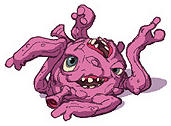 I won’t tell you what exactly you find, but I guess it’s
not giving too much away to say that “the Ur-Quan have already
been resoundingly defeated without your help” isn’t it.
I won’t tell you what exactly you find, but I guess it’s
not giving too much away to say that “the Ur-Quan have already
been resoundingly defeated without your help” isn’t it.

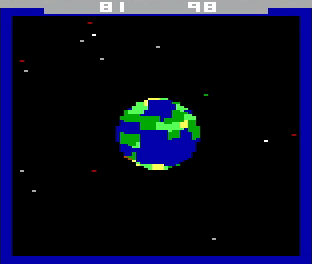















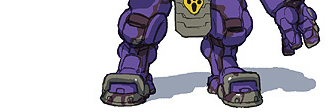 the sound of its
“Super-Melee” arcade mode echoed through the halls for
months.
There is a huge, wildly varied assortment of colorful ships to choose
from, each with its own distinctive abilities: one ship has a tractor
beam, one has a 50% chance of magically resurrecting itself after
being blown up, one can hypnotize enemy crew members into jumping out
the airlock, one can transform into a comet… it’s much
more fun than your standard space combat game.
I got really good at it.
Back in the day I could take out a whole fleet of thirty-point
Dreadnoughts,
Marauders, and Avatars with a single ten-point Thraddash Torch.
And yet when I think about
the sound of its
“Super-Melee” arcade mode echoed through the halls for
months.
There is a huge, wildly varied assortment of colorful ships to choose
from, each with its own distinctive abilities: one ship has a tractor
beam, one has a 50% chance of magically resurrecting itself after
being blown up, one can hypnotize enemy crew members into jumping out
the airlock, one can transform into a comet… it’s much
more fun than your standard space combat game.
I got really good at it.
Back in the day I could take out a whole fleet of thirty-point
Dreadnoughts,
Marauders, and Avatars with a single ten-point Thraddash Torch.
And yet when I think about  One is dryly sarcastic, one is new-age and daffy, one is full of double
entendres, one is made up of different species who bicker with each
other… you know how
One is dryly sarcastic, one is new-age and daffy, one is full of double
entendres, one is made up of different species who bicker with each
other… you know how  But compare
But compare 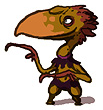 So when Captain Zoe met a species of toucan-like aliens, the game
declared that Captain Zoe was oafish enough to actively consider
“Hey! Bird-brains! Got any fruit loops? Har-har-har!” as a
greeting, and real-life Zoe had no say in the matter.
And then about midway through the game characters suddenly started
referring to her as “he”.
Note that there is no indication in the introductory slideshow
that you’re supposed to be playing a guy—we see both
men and women as the game describes your mission.
We
So when Captain Zoe met a species of toucan-like aliens, the game
declared that Captain Zoe was oafish enough to actively consider
“Hey! Bird-brains! Got any fruit loops? Har-har-har!” as a
greeting, and real-life Zoe had no say in the matter.
And then about midway through the game characters suddenly started
referring to her as “he”.
Note that there is no indication in the introductory slideshow
that you’re supposed to be playing a guy—we see both
men and women as the game describes your mission.
We 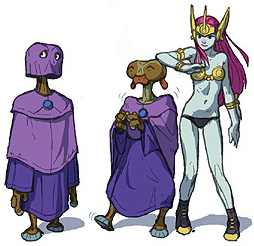 avoid giving the player character a distinct identity is nearly always
a mistake.)
avoid giving the player character a distinct identity is nearly always
a mistake.)
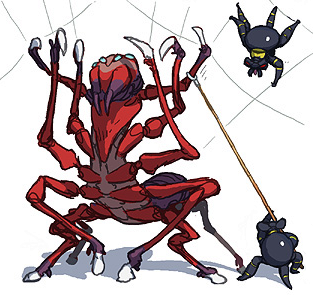 For instance, since Zoe tried to avoid combat whenever possible and
was frightened of the scarier aliens, she avoided a vast area of the map
where two of the main antagonists hung out.
If I hadn’t told her to talk to each of them at least once, she
might well have made it all the way to the winning ending without ever
having heard the bad guys tell their sides of the
story—i.e.,
For instance, since Zoe tried to avoid combat whenever possible and
was frightened of the scarier aliens, she avoided a vast area of the map
where two of the main antagonists hung out.
If I hadn’t told her to talk to each of them at least once, she
might well have made it all the way to the winning ending without ever
having heard the bad guys tell their sides of the
story—i.e., 


